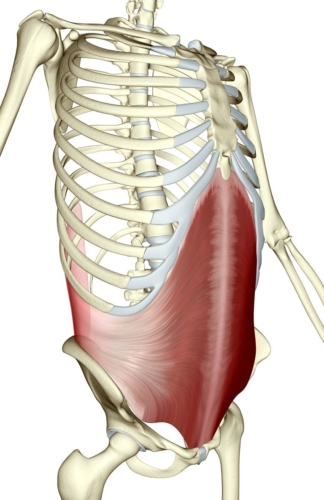By Dr Paul Batman, PhD.
DESCRIPTION:
The transverse abdominis is the deepest abdominal muscle extending across the abdomen in a horizontal direction.
ORIGIN:
Inguinal ligament, iliac crest, costal cartilages of the lower 6 ribs.
INSERTION:
Abdominal aponeurosis and linear alba.
MUSCLE GROUPS:
The transverse abdominis belongs to the following muscle groups:
Spinal joint flexors (helping).
STRENGTHENING EXERCISES:
Abdominal crunches, bent knee situps, reverse curl ups.
CASE STUDY STRENGTHENING EXERCISE: ABDOMINAL CRUNCHES.
- Lie on the floor in a supine position with your hips and knees bent at 90 degrees and your calves resting on a flat bench
- Support your head in your hands which are placed just above the back of your neck. Keep your elbows out to the sides of your head and avoid any pull of your arms
- From this starting position begin to slowly curl your spine up by contracting your abdominals
- Raise your head and shoulders up to a point approximately 30-45 degrees from the floor
- Pause momentarily then slowly lower your body down to the starting position
STRETCHING EXERCISES:
Abdominal stretch, lying lateral trunk stretch.
CASE STUDY STRETCHING EXERCISE: ABDOMINAL STRETCH.
1. Lie on the ground on your stomach with your arms directly in front
2. Gently raise your head and upper chest off the ground
3. Keep your head erect and eyes focussed forward
4. Continue the movement by arching your spine until you can rest on your elbows located beneath your body
5. Always keep your abdominals in contact with the ground
6. Do not excessively arch your back
7. Hold the stretch for approximately 20 seconds and then return to the starting position
PALPATION:
Due to its position under the superficial abdominal muscles the transverse abdominis is almost impossible to palpate.
TRAINERS TIPS:
1. The transverse abdominis is primarily used in forced expiration.
2. Its other main function is to flatten the abdominal wall or “pulling the belly in”.
3. Abdominal soreness from aerobic or anaerobic exercises is usually due to the transverse abdominis involvement. Sometimes called the “laughing muscle”.
4. A strong abdominal wall is important for good back health, venous return of blood back to the heart and positioning of the internal organs.
